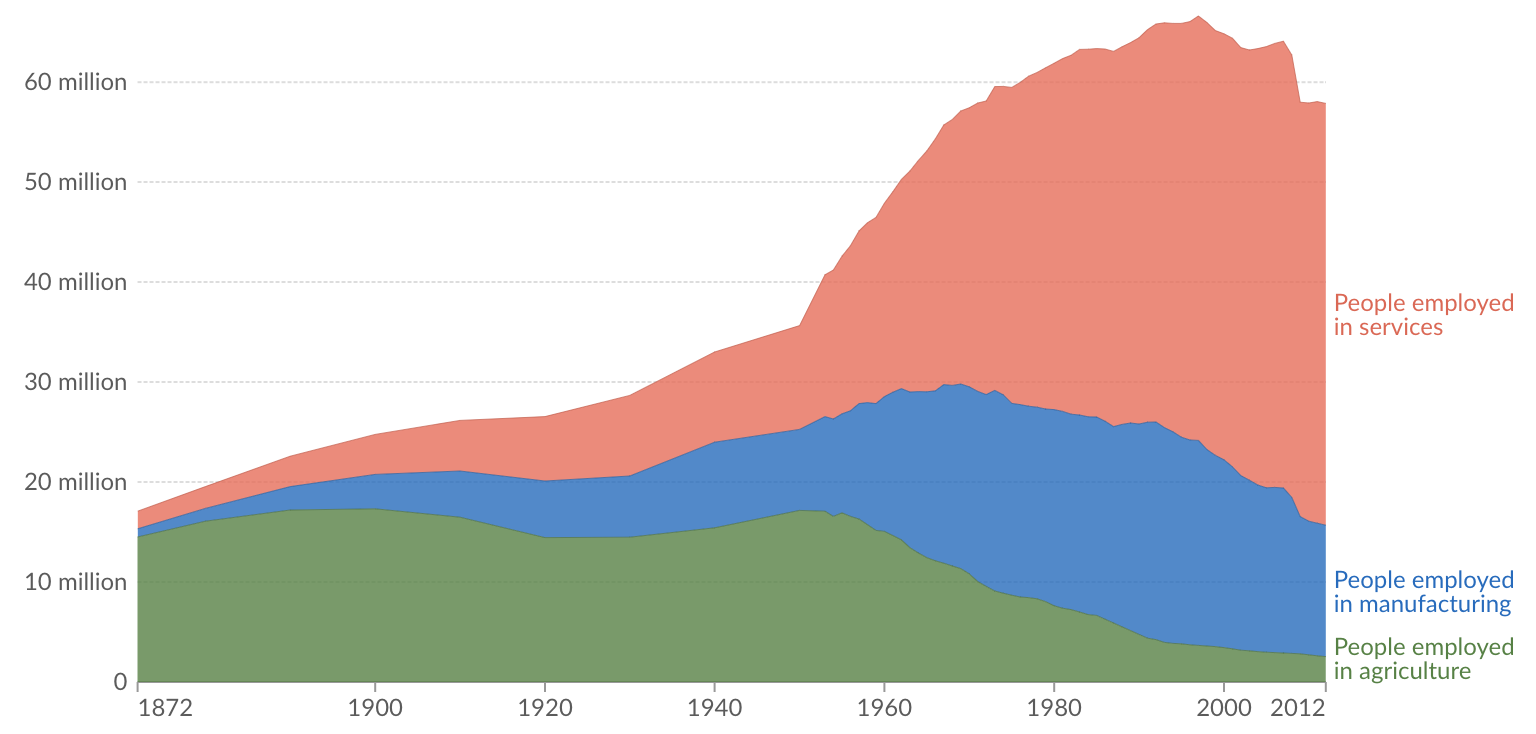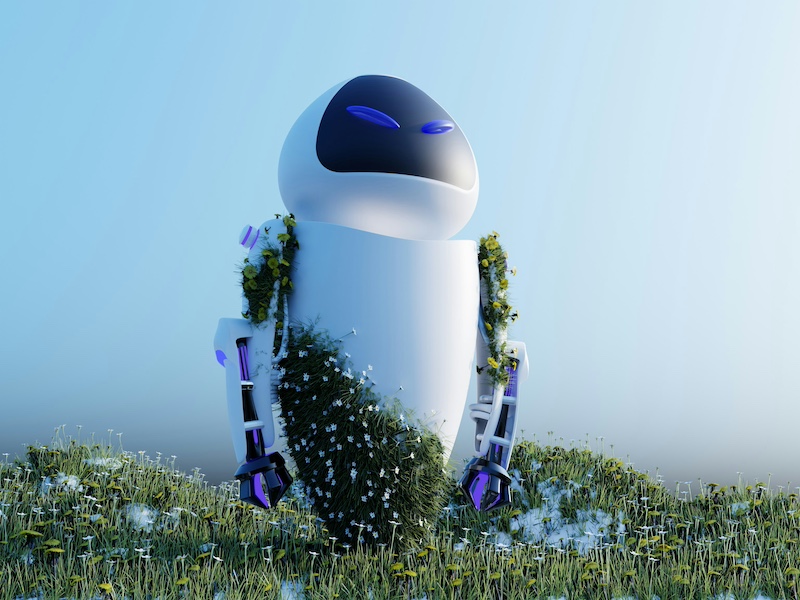A conflict of interest lies at the heart of Artificial Intelligence
AI could replace 300 million full-time jobs by 2030. It has the potential to be billions of times smarter than humans. That explains why developing it has been likened to a child playing with a bomb. To create intelligence, to play God, is to meddle with that which we don’t fully understand.
AI could be unbelievably dangerous. But wrapped around that danger is a tantalising opportunity to transform the world of work and our roles in society. That’s if we seek to take advantage of it in the right ways.
McKinsey defines AI as a “machine’s ability to perform some cognitive functions we usually associate with human minds”. Our drive to create it comes down to one thing — production.
Productivity has been an obsession since the Industrial Revolution because the better we get at harnessing energy, the more productive we become. That’s what industry and technology are all about. They allow us to make more stuff in ways that would be impossible without them. So why is this important?
A line in the sand
Before the Industrial Revolution, every country had an agrarian economy because, without the aid of technology, agriculture is labour-intensive.
Industrialisation freed people from agriculture. Take Japan. As late as 1950, 48 per cent of the population was employed in agriculture, 23 per cent in manufacturing and 29 per cent in services.

In the next 30 years, rapid economic growth saw Japan become the second-largest economy in the world. Growth has seen a dramatic shift in employment.
As of 2012, just 4 per cent of the population was employed in agriculture, 23 per cent in manufacturing and 73 per cent in services.
Globally 27 per cent of the workforce remains employed in agriculture. But as the map below shows, there is a strong correlation between wealth and lower employment in agriculture.
In high-income countries, average employment in agriculture is 3 per cent. In low-income countries, an average of 60 per cent work in farming and rely on it as their primary source of income.

The problem
Our increased ability to extract energy from fossil fuels has contributed to an explosion in production. But this comes with terrible costs.
Since 1750, we’ve released 1.5 trillion tonnes of carbon dioxide into the atmosphere. It appears the rewards of increasing production (higher living standards), outweigh the risks of catastrophic environmental change.
So, what does any of this have to do with AI? Again, it all comes down to production.
AI can create all kinds of efficiencies in the manufacturing and service industries that can greatly enhance production. This should leave us all better off, hence the tantalising opportunities, but the biggest opportunity of AI also happens to be the biggest danger.
The dangers
Energy demands
An obvious danger has been hinted at. The issue with AI is that, like anything else, it requires energy to work.
AI is becoming so much more sophisticated thanks to the internet. Every online interaction is stored in vast remote servers. These data centres require lots of energy. The International Energy Agency estimated data centres currently account for about 1 to 1.5 per cent of global electricity use.

AI draws on information from these data centres, which makes it energy-intensive. Should current trends in AI pickup continue, it’s estimated that by 2027 AI will consume 85.4 terawatt-hours of electricity annually.
The point here is that to overcome the climate crisis, we need to reduce carbon dioxide, which involves reducing energy demands, a prime culprit being electricity use.
The deployment of AI on a wider scale will see electricity demands increase, which will see emissions remain stubbornly high. Another nail in the coffin when it comes to overcoming the climate crisis.
Like a child playing with a bomb
As well as contributing to the mega trend to end all megatrends, the reason AI has been likened to a child playing with a bomb is based on just how intelligent it could become.
Consider our brains use neurons for information processing, and thereby for our thinking and feeling. It takes a neuron a microsecond to travel one foot. AI ‘brains’ use electrons to ‘think’. It takes an electron a nanosecond to travel the same distance.
That’s a million times quicker than a neuron.
To put it another way, what it would take a human to process in a year, would take AI operating at this speed, thirty seconds. With a processing speed which is, obviously, difficult to get our heads around, AI has the potential to be billions of times smarter than humans.
A danger with super intelligent AI is that AI doesn’t ‘think’ in the same way humans do. It exhibits ‘emergent behaviours,’ meaning we don’t always get the outputs that have been programmed. An example is Microsoft’s AI Chatbot ‘Tay’, which became racist within a day.
AI just isn’t as predictable and controllable as we would want it to be.
And this is before we even consider robotic technology. If AI is the ‘brain’ of our creation, then the metallic frame is the body. Combine the two and robots will be far stronger, and incomprehensibly more intelligent than we could ever dream of being.

It’s simply not possible to foretell what could happen should we unleash super-advanced robotics. A risk is that AI may just decide to take control, after all, we provide the inputs of information they draw upon. When analysing human behaviour, robots will see a history defined by a struggle for control.
This explains why AI is considered as big a risk as nuclear bombs or pandemics.
A return to feudalism?
If the Industrial Revolution was the precursor to eliminating the need for people to work in agriculture, AI has the same potential to replace people in manufacturing and services.
That explains the estimate that AI could replace 300 million full-time jobs by 2030. Ultimately though, there is no way of knowing the true scale of the upcoming transformation of the labour market.
Humans may become surplus to requirements in the labour force. This creates profound issues when it comes to how the fruits of increasing production — rising incomes— are distributed.
The circular flow of the economy illustrates how wealth is currently created and distributed throughout the economy. There are three protagonists involved in the circular flow of the economy — firms, households (comprising people) and banks. Their roles are as follows:
- Firms — invest in capital, like buildings and machinery, to produce the goods and services households want and need. Firms employ people from the labour force to make goods and services. Revenue from the sale of goods and services allows firms to pay employees income.
- Households — offer their labour to firms in exchange for income. People spend some of their income on consumer goods while saving the rest in banks.
- Banks — use some of the savings from households to invest in firms.

Where does AI fit into the circular flow of the economy? The answer is simple, it doesn’t. If we were to find a fit for AI, it would be a worker (hence why there are so many concerns that it will act as a job killer), which contributes to increasing productivity, and helps increase revenues.
If more and more jobs are being replaced by AI, then we’ll still be creating the same amount of wealth. The issue is that the mechanism used to distribute wealth through society (in the form of employment and income), will become increasingly unviable if entire sectors are replaced by AI.
It has to be said, this mechanism doesn’t exactly work brilliantly at the moment. Rising inequality is a sign that a disproportionate amount of wealth is being filtered into the hands of the richest, while the poorest don’t make enough to make ends meet.
But inequality can only be pushed so far. AI or robots won’t be taking home a wage, and they won’t be consuming goods and services. If mass unemployment becomes the order of the day, many goods and services will become unaffordable, so the economy will break down.
What’s needed more than ever, is a different mechanism for distributing wealth. That’s why AI creates a tantalising opportunity.
The opportunities
Universal basic income
The solution to the problem of, how we distribute wealth differently, can be found in the form of a Universal Basic Income (UBI). A UBI guarantees each adult citizen a no-strings-attached monthly payment from the government.
Rather than a trickle-up effect, where the fruits of economic output tend to filter into the hands of the few, a UBI distributes wealth across society.
It’s not like a UBI is some far-out utopian idea. In 2017, Finland carried out a two-year trial paying 2000 unemployed adults €560 ($635) a month. After two years, assessments showed no meaningful difference in job-finding rates among those receiving the payments compared to other unemployed workers.
Those getting a UBI did report being happier, though. While it’s not possible to know the effects of a UBI if it were implemented nationwide, the Finns concluded that a restructuring of their welfare state would allow a UBI of €560 to be paid to each adult citizen, without raising taxes.

The great emancipator
In the same way that the Industrial Revolution emancipated people from toiling on farms, AI has the potential to emancipate vast sways of the workforce from work altogether.
Should a UBI be implemented, rather than viewing AI as competitors in the job market who are replacing people, each job AI can take over will be a cause of celebration. After all, production will be maintained, while less people will be needed in the production process.
Should we use AI and see it as a great emancipator, rather than something we are competing against in the labour force, then we could be on the cusp of the most radical social transformation since that line in the sand that was the Industrial Revolution.
A crossroads
It would be utterly futile to develop AI to simply increase production, (which leads to economic growth), because a growing economy needs increasing inputs of energy and resources. This has led to the economy becoming enormous in scale.
It’s now so big that we need more inputs of energy and resources from the natural world, then Earth can renew in a year. A situation known as ecological overshoot. Overshoot translates into the climate crisis, biodiversity collapse, and habitat destruction. Ultimately, overshoot risks social collapse.
Creating sustainable societies, where needs are met within environmental limits, requires a profound social transformation. It requires us to produce less in more efficient ways. All while ensuring people’s needs are met.
AI could support us in enabling that transformation. Seeing as we’re locked into an economic growth which demands economic growth at all costs, the more likely scenario is that it will be used to increase production which will see overshoot (and all of the accompanying environmental problems), get worse.
AI could liberate humanity from the burden of work. It could support the transformation of society onto a sustainable path. It could mark a new dawn in the human experience. But only if we use it in the right ways.
That word, if, is the longest two-letter word in the dictionary. History is littered with what-ifs. With defining points that, had a different path been chosen, society would have developed in dramatically different ways. Somewhat depressingly, time and time again history is defined by a minority choosing to prioritise their self-interests over the common good. Let’s hope our use of AI bucks the trend. I wouldn‘t count on it, though.



